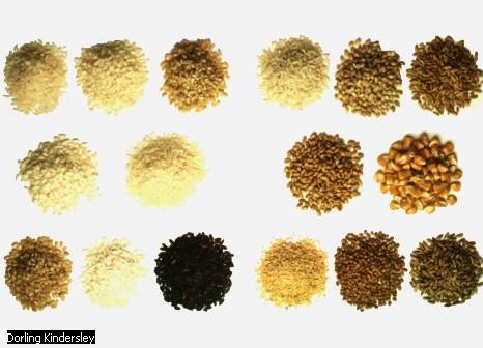
and grain plants

Grain is the common name for the fruit of certain cereals of the grass family. The seedlike fruits are major sources of carbohydrates in human diets worldwide. But food is not the only use of many grains. Many grains contain large quantities of starch, sugars, oils, and chemicals. The stems, leaves and other parts of the plants are used for their fiber.
The leading grains include barley, corn, oats, rice, rye, and wheat.

Corn
Approximately 61 percent of the corn sold by farmers in the United States is used as livestock feed. About half of that amount is fed directly to hogs, cattle, and poultry, and the rest is used in mixed feeds. Another 22 percent of U.S. corn is exported; the remaining 17 percent is sold as food and taken by commercial users for the production of alcohol and distilled spirits, syrups, sugar, cornstarch, and dry-process foods.
Corncobs are an important source of furfural, a liquid used in manufacturing nylon fibers and phenol-formaldehyde plastics, refining wood resin, making lubricating oils from petroleum, and purifying butadiene in the production of synthetic rubber. Ground corncobs are used as a soft-grit abrasive. Large, whole cobs from a special type of corn, "cob pipe" corn, are used for pipes for smoking tobacco. Corn oil, extracted from the germ of the corn kernel, is used as a cooking and salad oil and, in solidified form, as margarine; it is also used in the manufacture of paints, soaps, and linoleum. The search for alternate sources of energy has brought attention to corn as a fuel source. High in sugar content, corn is processed to produce alcohol for use with gasoline as gasohol, and the dry stalk is a potentially important fuel biomass.
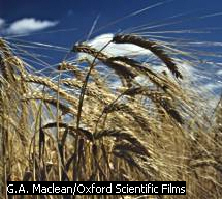 Maize,
another name for corn, is the only grain that originated in America;
the others were developed in Europe, Asia, and Africa.
Maize,
another name for corn, is the only grain that originated in America;
the others were developed in Europe, Asia, and Africa.
Barley
Barley grain, hay, straw, and several by-products are used for feed. The grain is used for malt beverages and in cooking. Like other cereals, barley contains a large proportion of carbohydrate (67 percent) and protein (12.8 percent).
Oats
Oat grains, as harvested, consist of highly digestible seed held within an indigestible hull. Compared with other grains, whole oats produce feeds that are high in protein, fat, and fiber and low in carbohydrates. Oat varieties are being developed with improved yields, higher protein and energy content, and stronger resistance to rust, to virus diseases, and to attacks by insects.
As cereals and porridges, which are derived from roasted grains, oats are high in protein and are particularly good sources of thiamine, or vitamin B1. In recent years the use of oats has been extended to ready-to-eat breakfast cereals and a wide variety of processed foods. Oat flour contains antioxidants that retard rancidity in fat-containing foods; it is an ingredient of such products as peanut butter, margarine, chocolate, and doughnut flours and is a preservative inner coating for the paper bags used to package salted nuts, coffee, and potato chips. Oat flour also serves as a fat stabilizer in ice cream and other dairy products. The most important industrial product from oats is furfural, a chemical derived from oat hulls and used as a solvent in various refining industries.
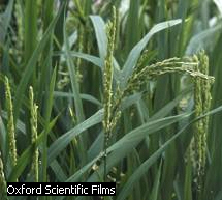 Rice
Rice
Rice, plant that produces an edible grain; the name is also used for the grain itself. Rice is the primary food for half the people in the world. In many regions it is eaten with every meal and provides more calories than any single food.
Asian countries produced about 90 percent of the 569 million tons of rice grown worldwide in 1996. Typically, China and India together produce about 55 percent of the world's rice, and it is a significant agricultural crop in more than 50 other countries. About 96 percent of the rice grown worldwide is consumed in the countries where it is produced, with some exceptions.
Rice is used for a variety of food and nonfood products. Foods include cooked rice, breakfast cereals, desserts, and rice flour. Rice is also used in beer and in sake, a Japanese fermented brew. The inedible rice hull is used as fuel, fertilizer, and insulation, while the bran is a source of cooking oil. Straw from the leaves and stems is used as bedding for animals and for weaving roofs, hats, baskets, and sandals.
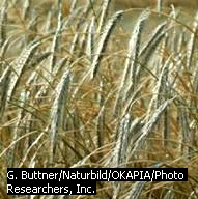 Rye
Rye
Rye is the common name for an annual cereal grain of the grass family, allied to wheat and barley. Rye is native to temperate Eurasia where it is most heavily used as a bread grain (mixed with other grains) and as a livestock feed. It is less important as a grain crop in other parts of the world. Rye is also used as hay and straw; its straw, tougher than that of other cereals, is valued for straw plait. In addition, mashes of more than 50 percent rye are used to make rye whiskey.
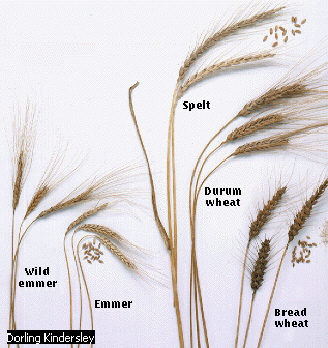 Wheat
Wheat
Wheat, common name for cereal grasses of a genus of the grass family, cultivated for food since prehistoric times by the peoples of the temperate zones and now the most important grain crop of those regions.
The main use of wheat is in the manufacture of flour for bread and pastries. In general, hard varieties are used for bread flour and soft varieties for pastry flour. Wheat is used also in the production of breakfast foods and to a limited extent in the making of beer, whiskey, and industrial alcohol. Low grades of wheat, and by-products of the flour-milling, brewing, and distilling industries, are used as feed for livestock. A minor amount of wheat is used as a coffee substitute, especially in Europe, and wheat starch is employed as a sizing for textile fabrics.
Other grains are millet, sorghum, wild rice, and triticale.
Millet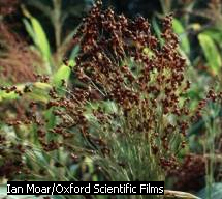
Millet, common name for several species of the grass family, and for their small-seeded grain, which is used to make porridge and flatbreads or as food for livestock. Among the better-known millets is common millet, or proso, which is grown as food in China, India, central and western Asia, and eastern Europe, and as feed for poultry, wild birds, and livestock in the United States. Pearl millet is the tallest millet and has the largest grains, which appear on long spikes similar to those of cattails. It is a common food in Africa, India, and Asia and is grown as fodder and silage in the United States.
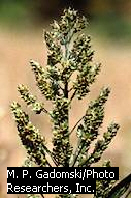 Sorghum
Sorghum
Sorghum, common name for cornlike grasses native to Africa and Asia, where they have been cultivated since ancient times. Up to10 feet tall, they bear seeds on terminal heads. Grain sorghums are the staple food for millions of people in China, India, and Africa; in the U.S. sorghums serve primarily as livestock feed.
Sweet sorghums develop a sweet juice in their stalks and are grown for syrup production and fodder. Historically these plants were widely used in making brooms, but plastics are taking their place. Increased use of liquid sweeteners has expanded interest in sweet sorghums for this purpose.
Wild Rice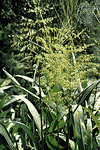
Wild Rice, also Indian rice, common name for an annual aquatic grass. The name is misleading because wild rice is not closely related to common cultivated rice. The plant grows wild in swamps in the northeastern United States and Canada, often reaching a height of9 feet. Because the seeds of wild rice attract fish and waterfowl, the grass is planted in ponds and marshes by sports enthusiasts. Wild rice is also harvested for its grain, considered a delicacy, and is often served with game or poultry.
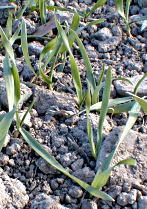 Triticale
Triticale
Triticale, cereal grass crop developed by crossing wheat and rye. Triticale is the first species of an agricultural crop produced scientifically by humans. Used for both human food and livestock feed, its major advantage over other cereal grasses is a high grain yield even under adverse growing conditions, such as acidic soils or heavy competition from weeds.
The nutritional quality of triticale is superior to both wheat and rye, making it an excellent cereal grain. However, its dough lacks the strength for making bread unless mixed with wheat flour. Triticale grain is also fed to poultry and other livestock.
A number of nongrass plants are often called grains, such as buckwheat, flax, and the soybean, a legume.
Buckwheat
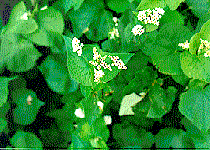 Buckwheat,
common name for a plant family and for one of its 30 genera. Members
of the genus are not related to the true wheats, which belong to the
grass family.
Buckwheat,
common name for a plant family and for one of its 30 genera. Members
of the genus are not related to the true wheats, which belong to the
grass family.
Common buckwheat is a native of the shores of the Caspian Sea and the region of the Amur River. It was introduced into Western Europe in about the 16th century. The plant is upright, branched, up to 36 inchs high. The leaves are heart-shaped, the flowers white or yellow-white, and the seeds black and triangular. The seeds are used for livestock and poultry feed and are ground into flour; the plant is used for forage and for litter. Bees make a dark, highly flavored honey from the blossoms. Buckwheat flour contains no gluten and somewhat less protein and somewhat more starch than wheat.
Flax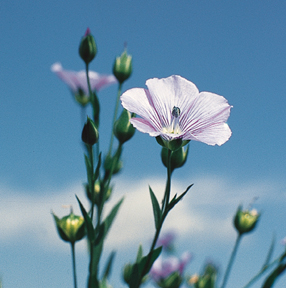
Flax, common name for a family of plants, and for plants of a genus within that family. One species is grown extensively for its fiber and seed. The fiber products include linen threads and fabrics, and the seed is the source of linseed oil and meal. Other species are cultivated as ornamental plants or for pharmaceuticals.
The retted stems are crushed and broken and the fiber is separated from the woody fragments, called shives. This process yields relatively long and straight fibers, known as line fibers, and short, damaged or tangled fibers, called tow. Flax tow is used primarily in upholstery. Having high tensile strength, line fibers are used in the manufacture of various threads employed in the bookbinding and shoe industries and in such products as twine, fishnets, and laces.
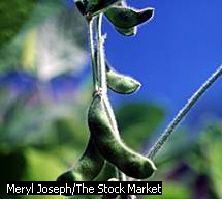 Soybean
Soybean
Soybean, also soy and soya bean, are the common names for an annual pod plant and its seeds. The soybean probably originated in eastern China and is widely cultivated as a farm crop. The two basic products of the soybean are protein meal and oil. In the United States, more than 90 percent of the oil is consumed as margarine, shortening, mayonnaise, salad oils, and other edible products; the rest is used in industrial products such as paint, varnish, linoleum, and rubber fabrics. Soybean meal is the major source of the protein supplement used in livestock feeds, which utilize 98 percent of the total meal produced. In the protein-short areas of the world and elsewhere, soybean meal is finding increasing use in human food products.